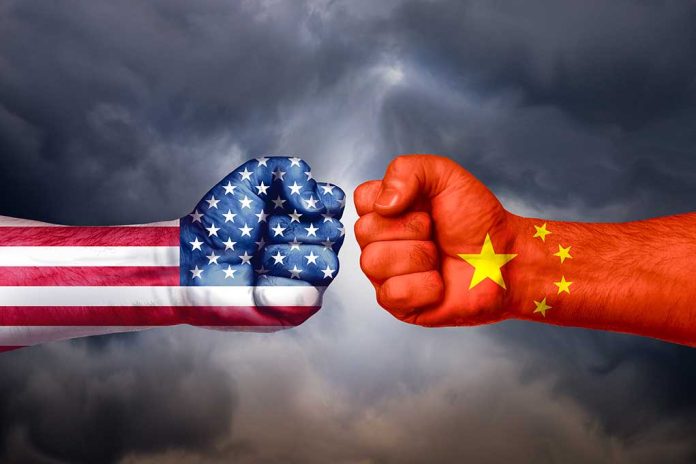
China strikes back with 34% tariffs on US goods as the trade war intensifies, threatening to disrupt global markets and supply chains with rare earth export controls that could cripple American high-tech manufacturing.
Top Takeaways
- China has imposed a 34% tariff on US imports effective April 10, directly retaliating against President Trump’s recent tariff increases on Chinese goods.
- Beijing is escalating tensions by adding export controls on critical rare earth elements needed for high-tech manufacturing and adding 27 US companies to its sanctions list.
- The Chinese government has filed a complaint with the World Trade Organization, claiming US tariffs violate international trade rules.
- Global stock markets have experienced significant losses following the tariff announcements, indicating broader economic concerns.
- Despite the escalation, both nations have signaled openness to negotiations while defending their respective positions.
Trade War Escalates as China Retaliates
In a significant escalation of trade tensions, China announced a 34% tariff on US imports, effective April 10. This move directly counters President Trump’s recent implementation of additional tariffs on Chinese goods, which raised the total US tariff on some Chinese products to at least 54%. The Chinese foreign ministry characterized the US tariffs as violating World Trade Organization rules and undermining the rules-based multilateral trading system. Beijing’s response signals its unwillingness to accept what it views as unfair trade practices without a proportional response.
The retaliation extends beyond simple tariff increases. China announced additional export controls on rare earth elements, which are critical components for high-tech products, including electronics, electric vehicles, and defense systems. Beijing also placed 27 US companies on its list for trade sanctions and export controls, and suspended imports of certain US agricultural products. These actions demonstrate China’s strategic approach to maximizing pressure on key US industries while protecting its own economic interests.
WTO Complaints and Global Market Impact
China has filed a formal complaint with the World Trade Organization against the US tariffs, escalating the dispute to the international level. This legal challenge seeks to position China as defending the global trading system against what it characterizes as American protectionism. The trade conflict has already caused significant volatility in global markets, with stock exchanges recording substantial losses following both countries’ tariff announcements. Economic analysts worry about potential disruptions to supply chains and increased costs for consumers and businesses on both sides.
The economic stakes are enormous, with US imports from China totaling $438.9 billion last year, while exports to China amounted to $143.5 billion. This trade imbalance of $295.4 billion serves as a central justification for President Trump’s tariff policies, which he has described as “reciprocal.” The US economy added 228,000 jobs in March, surpassing estimates and potentially bolstering the administration’s confidence in its trade strategy regardless of Chinese retaliation.
Domestic Support and Criticism
The tariff battle has generated mixed reactions within the United States. Supporters of the administration’s approach argue that firm action against China is necessary to restore American manufacturing and protect US workers. Republican Representative Jeff Van Drew defended the policy, acknowledging potential short-term challenges while focusing on the longer-term benefits. He stated, “We knew this was going to be a little bit bumpy in the beginning, but let’s understand what it’s about. It’s about fairness. It’s about America first, not America last.” The White House has positioned these tariffs as vital for defending American workers and industries against unfair foreign competition, particularly from China.
However, economists and foreign governments have criticized the US tariff methodology as unfair and misrepresentative of actual trade imbalances. Critics warn that American consumers will ultimately bear the cost of these tariffs through higher prices on imported goods. The unexpectedly high 34% Chinese tariff suggests Beijing is taking a more aggressive stance than in previous trade disputes, possibly calculating that a forceful response might bring the US back to the negotiating table under more favorable terms.
Potential for Negotiated Resolution
Despite the escalating tensions, both countries have indicated some openness to negotiations. China’s Ministry of Finance has called for resolving trade disputes “through consultations in a manner of equality, respect and reciprocity.” Analysts suggest China may be willing to make concessions on certain issues, such as potentially allowing the sale of TikTok’s US operations, in exchange for tariff relief. These signals suggest that the current tariff war might eventually lead to new trade agreements rather than continued escalation.
The most concerning aspect for US industries may be China’s non-tariff measures, particularly restrictions on rare minerals essential for manufacturing advanced technology products. These elements are critical for electronics, defense systems, and clean energy technologies, giving China significant leverage. As both nations dig in their heels, businesses and consumers on both sides of the Pacific prepare for potential price increases and supply chain disruptions while hoping diplomatic efforts might prevail before further economic damage occurs.
Sources:
- China retaliates with 34% tariffs on US imports
- Trump’s tariffs prompt China to retaliate with 34% levy on US imports, rare earth element export controls
- China hits back at Trump with 34% tariff on US imports







